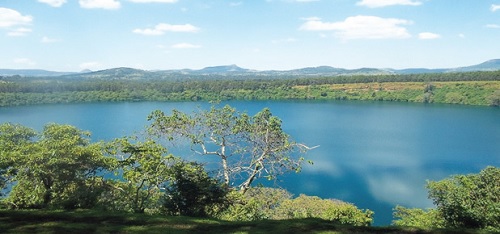
Ethiopia is home to over 20 lakes that are bottomless pools of attractions and can offer unforgettable experience and leave lasting memories on visitors both local and foreign tourists. Including the most famous tourist destinations, such as Lake Tana, Lake Hawassa Lake Bishoftu, Lake Chamo and Lake Abiyata, the country is home to over 20 lakes which all have their own distinctive attraction elements- recreational and refreshing (sport adventures, swimming and fishing), natural, historic, cultural attractions.
For instance, the largest lake, Lake Tana, which possesses religious, natural as well as historical elements for having a number of ancient island monasteries, being the source of Abbay River, and famous for its aquatic bird life, Lake Bishoftu for its recreational value are some to mention but a few.
Zengena Lake, which is less known, is the other Crater Lake located in the western Ethiopia, in the Awi Zone of the Amhara State. The Lake is situated six km south of Kosso Ber between the towns of Injibara and only 200 m from the Addis Ababa-Bahir Dar highway at an elevation of 2500 m. The diameter of the lake is roughly 1 km.
As studies indicate, Zengena, with a maximum depth of 166 m, is the second deepest lake in Ethiopia after Lake Shala. Its rim is made of unconsolidated ash deposits. Zengena Lake is most likely a maar lake formed by volcanic explosion and collapse. Though it is not proved, as villagers uttered, the formation of this Lake has a myth that is told by the community which is similar with the biblical history of Noah and flood water.
Vegetation around the crater rim is dominated by a plantation of Cupressus lusitanica which is managed by the Agricultural Bureau in Kosso Ber. Some poorly developed natural vegetation exists inside the crater on the steeply sloping sides. The Lake at the bottom is almost inaccessible, but can be reached by those who are sure-footed. The water is fresh.
Excessive algal growth was not observed when looking down from the top. The Lake is found in the vicinity of a rapidly growing town. In the surrounding of the Zengena Lake watching troops of Abyssinian Colombus Monkeys, (locally known as Gureza), peering down on visitors graced with their fluffy, white tails and faces, white fur around the perimeter and a topi-style dark fur on top of heads, is not unusual moments.
According to a piece produced by Zemenu Bires Beza with a title’ Challenges and Prospects of Community Based Ecotourism Development in Lake Zengena and its environs, the Lake and its surrounding have plenty of tourism potential. The natural resources of the Lake and its environs include a variety of wildlife which includes avian species, reptiles, fish species such as the resilient Tilapia and a host of mammals.
The bird species include inter alia, Alopochenae gyptiaca (Dakiye), Aquila rapax (Chilifit), Wattled Ibis (Bale-Enitiltil Gagano). Not only that, but the mammals include the Spotted Hyena (Jib), the Anubis baboon (Monkey/zinjero), Common bushbuck (Dikula),and other mammals which can all be found in close proximity to Lake Zengena.
The other natural resources include nearby mountain’s such as Darkan Mountain, in a North Westerly direction which is still untouched by any tourism activity, but with a potentially good view point of the surrounding area. The Gubil Mountains, located in a South Westerly direction of Lake Zengena and they are covered by very dense forests comprising mainly highland evergreen trees are the magnificent attraction of the Lake. The birds and mammals found in the mountainous areas, the bamboo plantations are also the other blessings that offer abundance of fresh air and environmental beauty for the Lake Zengena
The cultural tourism resources found around the Lake are also the other tourism potential of Lake Zengena. The popular Monasteries of Felege Hiwot Kidus Gabriel, Debre Mihret Kidus Michael, coupled with handmade traditional goods (those prepared from bamboo trees, horse tails Chira) and other cultural assets have a big potential to entice the eyes of visitors, and help develop community business enterprises. These items could all be manufactured as souvenirs and also used to develop culturally driven art galleries in the area.
COMPILED BY STAFF REPORTER
The Ethiopian Herald May 22/2021





